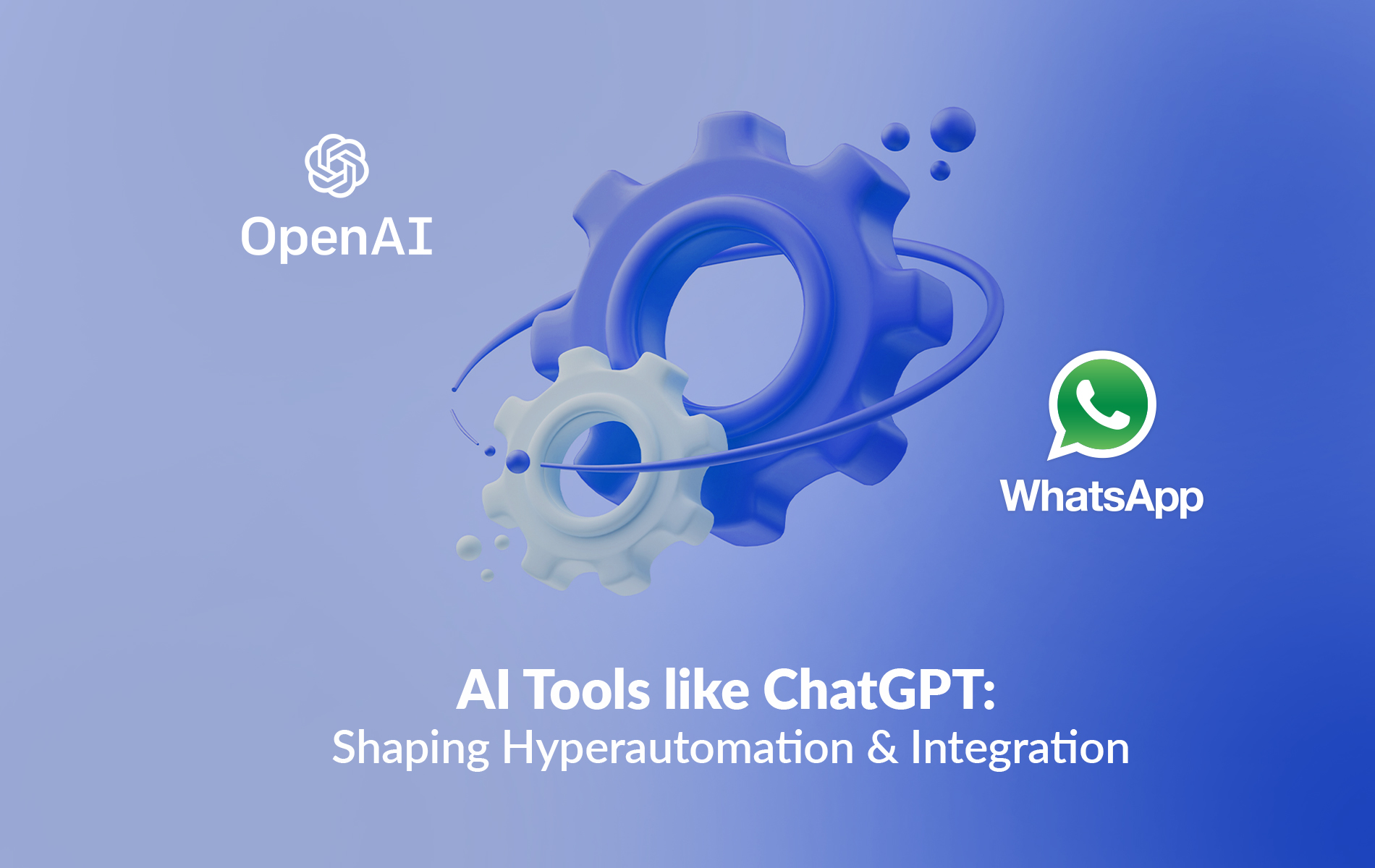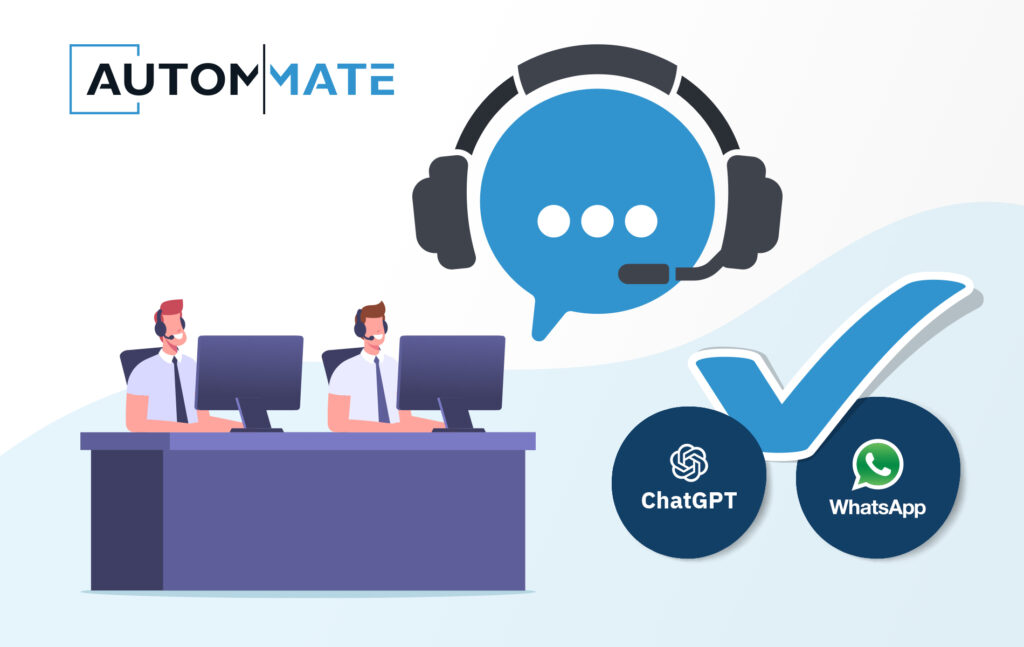Hyperautomation, fuelled by cutting-edge technologies like artificial intelligence and machine learning, has become a vital approach for businesses aiming to streamline processes, reduce costs, and enhance efficiency. As AI tools such as ChatGPT develop and gain traction, they’re set to reshape hyperautomation and integration, offering remarkable value to organisations.
AI-driven automation holds immense promise, from increased productivity and cost savings to boosted innovation and adaptability to ever-shifting business needs. However, it’s essential to address the challenges and ethical considerations that come with AI technologies. Data biases, privacy concerns, and intellectual property rights are some of the critical aspects organisations must tackle to fully harness AI’s potential.
In this blog post, we’ll delve into the transformative potential of AI technologies as they unlock new opportunities in content creation, decision-making, and problem-solving. We’ll explore how AI solutions can seamlessly integrate applications, systems, and processes, enabling organisations to automate end-to-end business operations.
The rise of generative AI and its potential in business processes
Generative AI and other foundation models are transforming the area of artificial intelligence by reducing the amount of time spent on application development and introducing complex capabilities to non-technical users. The topic of content production is among the most important areas where generative AI is being used. For marketing and promotional purposes, it can be used to produce realistic images and videos, for instance. Additionally, it can create interesting social media posts and tailored emails that can help firms more successfully contact their target audience.
Generative AI also has the potential to improve problem-solving and decision-making in business processes. By analysing large amounts of data, it can generate insights and predictions that can help companies make better decisions. For example, it can be used to identify patterns in customer behaviour and generate recommendations on how to improve customer satisfaction.
ChatGPT has proven its ability in content generation, problem-solving, and decision-making as a big language model trained by OpenAI. With the help of its sophisticated natural language processing abilities, it can understand and answer complex questions and can produce responses to text prompts that are human-like. ChatGPT can produce top-notch blog posts, product descriptions, and social media posts. Additionally, it might inspire the writing of creative works like poetry and short stories. It can develop answers to difficult problems and offer insights and recommendations based on data analysis when it comes to problem-solving. It can offer suggestions for decision-making based on the analysis of data and patterns.
Creating seamless chatbots with AI tools and iPaaS
For organisations looking to improve customer engagement and optimise operations, chatbots have become a crucial tool. It is difficult to develop a chatbot that is smooth and capable of understanding and naturally responding to client inquiries. This is where iPaaS and AI together are useful. Businesses may build chatbots that comprehend natural language and offer tailored responses by fusing AI and iPaaS. OpenAI’s ChatGPT AI model can be used to produce conversational flows and responses that seem human-like and natural. These responses can be smoothly included in the chatbot system with the use of iPaaS.
There are many advantages to creating chatbots by combining AI with iPaaS. First and foremost, technology makes it possible for companies to offer 24/7 customer support without involving any human beings. Costs are reduced as a result, and customer satisfaction is raised. Second, chatbots powered by AI can comprehend and reply to client inquiries in real-time, offering prompt assistance and cutting down on response times. This can greatly enhance consumer satisfaction and assist companies in creating a positive brand image.
At last, chatbots may learn from client interactions and develop better responses over time by utilising AI and iPaaS. As a result, a chatbot’s responses to client inquiries become more precise and effective. In conclusion, organisations have a strong tool to build intuitive chatbots that may improve customer interaction and expedite processes thanks to the combination of AI and iPaaS. Businesses may use ChatGPT to build chatbots that sound realistic and human-like, improving the customer experience. We may anticipate that chatbots will advance in sophistication and prominence in the area of customer service as AI technology continues to advance.
Revolutionising data and application integration
The successful integration of data and applications is essential in the modern workplace. It can be difficult and time-consuming to create pipelines using conventional methods for data extraction, transformation, preparation, and pipeline building. However, current developments in AI are changing the integration landscape. One such example is Natural Language Processing (NLP). By allowing users to enter queries in common English instead of using complicated coding or scripting, NLP makes data extraction simpler. This technology can interpret the user’s request’s purpose and deliver the necessary information. As a result, it takes less time and effort to extract data and the process is streamlined.
Data preparation and transformation are both being revolutionised by automation. Data mistakes and inconsistencies can be reduced by using machine learning techniques to automatically identify and clean the data. By recommending data transformations and augmentations, this technology can improve data preparation while also making it easier for users to complete. Another area where AI is making a big difference is in the construction and setup of data pipelines. Users may quickly and easily configure data pipelines with automated tools, requiring less technical know-how and lowering the time needed to build and manage pipelines.
AI is also helping with quality control and process troubleshooting for integration. Automatic detection and notification of users using machine learning algorithms of possible problems enable speedy remediation before it negatively impacts the business. It is impossible to overestimate how AI is affecting the integration of data and applications. AI is changing the game for businesses of all sizes by making data extraction easier, automating data transformation and preparation, expediting the development and setup of data pipelines, and assisting with quality assurance and troubleshooting. We can anticipate even more substantial advancements in the integration landscape as AI technology develops.
Empowering Hyperautomation through AI-driven insights
Data-driven decision-making, which calls for the ability to derive useful insights from enterprise data, is one of the main elements of hyperautomation. Here in lies the value of OpenAI’s newest language model, GPT-4. The way that organisations derive insights from their data may change thanks to GPT-4. GPT-4 can comprehend and analyse unstructured data from a variety of sources, including text, photos, and videos, thanks to its highly developed natural language processing (NLP) abilities.
Businesses can improve their decision-making and create value by utilising GPT-4’s capacity to produce insights from enterprise data. For instance, GPT-4 can assist firms in spotting patterns and trends in consumer behaviour, allowing them to develop marketing strategies that are relevant to their target market. Additionally, it can assist in locating inefficiencies in corporate procedures, enabling organisations to streamline their processes and raise their profitability.
Additionally, GPT-4 can automate a variety of processes that were previously carried out by people, saving both time and resources. Businesses may be able to use this to save expenses and boost productivity, which will ultimately result in higher profitability. The ability of GPT-4 to produce insights from enterprise data has the potential to revolutionise hyperautomation. GPT-4 can assist firms in remaining competitive and generating corporate value in the digital age by enabling them to make data-driven decisions and automate difficult procedures.
The Impact of AI Tools on Hyperautomation and Integration
Companies may improve their integration procedures and save time and money by utilising AI, which enables smooth end-to-end automation. The increased efficiency that AI-powered integration offers is among its most important advantages. Integration platforms can greatly reduce the time and resources needed to carry out data mapping and transformation by automating these processes. As a result, data is integrated more quickly across systems, allowing companies to make decisions in real-time based on accurate and current data.
AI-powered integration provides flawless end-to-end automation in addition to increasing productivity. Businesses may create a fully automated workflow that reduces the chance of errors and boosts productivity by automating the entire integration process, from data extraction through transformation and loading. The capacity of AI-powered integration to enable rapid innovation and agility in the face of shifting business needs may be its most significant asset. Businesses may adapt fast to shifting market conditions and gain a competitive edge by being able to swiftly and inexpensively integrate new data sources and applications.
AI tools are transforming the way businesses approach hyperautomation and integration. By improving efficiency, facilitating seamless end-to-end automation, and enabling rapid innovation and adaptability, AI-powered integration platforms are driving significant cost savings and improving productivity across a wide range of industries. As businesses continue to embrace the power of AI, the impact on hyperautomation and integration is sure to be profound.
Overcoming Challenges and Ethical Considerations
The use of AI technologies comes with a number of difficulties and moral dilemmas, as with any emerging technology. Addressing challenges like data biases, privacy concerns, and intellectual property rights are a few of them, as well as making sure that corporate rules, values, and culture are upheld. Businesses must take proactive measures to solve these problems and ensure that AI tools are applied morally and responsibly.
Preparing for the AI-driven Future of Hyperautomation and Integration
Businesses must determine the areas where AI technologies may have the biggest impact, promote innovation while keeping proper protections, and create an ecosystem of partners, communities, and platforms if they are to be ready for the hyperautomation and integration, drove future of AI. By doing this, companies can stay ahead of the curve and seize the chances that AI tools provide.
Hyperautomation Platform Autom Mate is Ready for the AI Revolution
Businesses are increasingly looking to utilise automation to streamline their operations and gain a competitive edge as a result of the rapid growth of artificial intelligence. This is where Autom Mate, a strong no-code/low-code platform, comes into play. It enables customers to quickly integrate and automate numerous business operations. Anyone, regardless of technical background, can easily construct automated workflows and connect disjointed systems thanks to Autom Mate’s drag-and-drop interface. Autom Mate offers the adaptability to handle a wide range of use cases, including integrating customer data from various sources, automating financial procedures, and improving supply chain management.
One of Autom Mate’s primary benefits is its no-code/low-code platform, which enables customers to design unique workflows without ever writing a line of code. Because of this, non-technical users may automate complicated operations with ease, saving money on costly development resources and hastening time-to-value.
With its capacity to automate operations across numerous industries and use situations, Autom Mate has virtually endless potential. The platform gives organisations the ability to design unique workflows that are tailored to their own requirements thanks to its user-friendly interface and strong AI capabilities.
With Autom Mate, the possibilities are endless, and as AI develops, the platform will only get stronger and more adaptable. Autom Mate is positioned to be a game-changer for enterprises trying to stay ahead of the curve in the digital era thanks to its capacity for handling a wide range of use cases and its endless possibilities for customisation.





